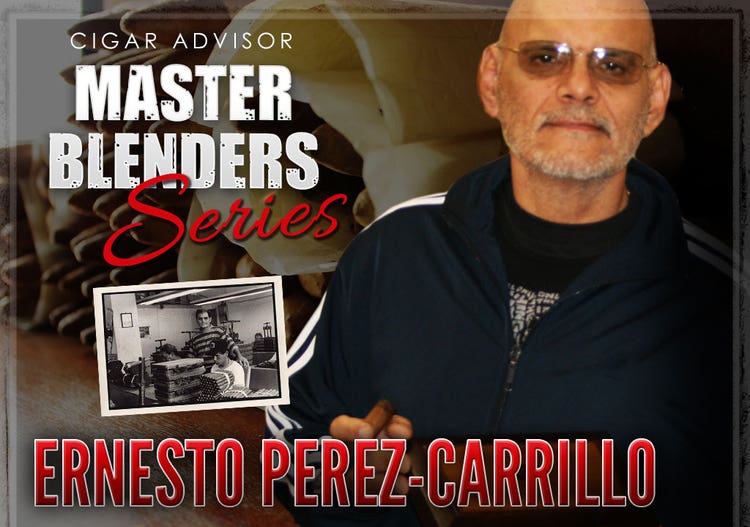
Master Blenders: Ernesto Perez Carrillo of EPC Cigars
Ernesto Perez-Carrillo. You may not recognize the name immediately, but once you see the list of cigars he’s made for the last 25 years, don’t be surprised if they are some of your personal favorites. Born in Cuba, after the Castro regime took control of the island in 1959, his father moved the family to Miami, FL and set up a small tabacalera in the Little Havana district. Ernesto studied drums as a young man with the hope of becoming a big band drummer. However, as it often does, Fate stepped in, and Ernesto, having learned the tobacco trade from his father, first-hand, became one of the world’s most highly-regarded and successful cigar makers. In this different sort of podcast, Ernesto discusses a number of topics: from why he prefers to use tobaccos from certain countries, to his recent E.P. Carrillo Cigar successes, the U.S.-Cuba trade embargo, the FDA, and his candid views on the cigar industry itself.
When I spoke to Ernesto for this interview, he was at his factory in the Dominican Republic preparing for this year’s IPCPR Trade Show. After thanking Ernesto for making time to speak with CigarAdvisor.com, I began our conversation with something that has always amazed me about the cigars he makes. Practically every cigar is blended with Nicaraguan and Dominican filler tobaccos and Ecuador-grown Sumatra wrappers. So, I asked him why he keeps returning to these three particular tobaccos.
Due to unforeseen circumstances the audio files for this interview have been corrupt and lost we apologize for this inconvenience.
Check out a new interview we conducted with Ernesto Perez Carillo here!
Next, we moved on to the EPC La Historia cigars. Limited edition cigars that pay tribute to their families has been a common thread among cigar makers; Perdomo has their Edición de Silvio, Fuente has their Don Carlos, etc. Obviously, it’s done out of love, but I wanted to know whether cigar makers tend to wait until they’ve achieved a certain level of success for such projects, or is it one of those things that just happens in the course of doing business.
La Historia came in at #2 in the “Top-25 cigars of 2014” last year. Going back to his La Gloria days, many of Ernesto’s cigars have made that list over the years, but because it was for La Historia, I asked him if landing in the #2 spot made it that much more special. Ernesto also talked about how Gilberto Oliva of Oliva Cigars (technically a competitor of his, but also a good friend), helped him get started when he founded E.P. Carrillo Cigars.
High rating scores are great for boosting cigar sales, but that aside, I wanted to know how much cred Ernest puts into ratings; so I asked him if he thought cigar smokers rely too heavily on ratings when it comes to deciding what cigars to buy.
Another cigar EPC released during the past year was the 5 Year Anniversary Toro, which I recently reviewed. I thought the Ecuadorian Sumatra wrapper was gorgeous, and asked Ernesto what he could tell us about it.
Next, we talked about how the INCH by EPC cigars were doing. I asked Ernesto if he felt the big giant cigar trend was growing, tapering-off, or remaining as-is. His answer was quite surprising.
Lately, I’ve asked several ex-patriot Cuban cigar makers how they feel about the easing of restriction regarding the U.S.–Cuba trade embargo. Ernesto’s family was among those that fled Cuba after the Castro regime took power in 1959, and made their new home in Miami, so I asked him for his take on the situation.
As a follow-up, I asked Ernesto if U.S. relations with Cuba were to finally allow free trade, whether he would start blending cigars with Cuban tobacco.
Like most of the premium cigar makers and retailers, Ernesto has been paying close attention to what’s happening in Washington regarding the pending FDA regulation of premium cigars. It’s been a long hard fight for the cigar industry, so I asked him how he thought our side was doing.
When Ernesto founded E.P. Carrillo Cigars, he wanted to bring his son, Ernesto III and his daughter, Lisette into the family business. Five years later, I asked him how his kids were doing and if they’ve lived up to his expectations.
Time to switch gears a little. Before he went into the cigar business, Ernesto dreamed of becoming a drummer with a big jazz band, and at one point he auditioned for the drummer’s seat in the Stan Getz Orchestra. So, I asked him how different he thought his life might be today had he been able to get that golden opportunity.
Having had such a long and successful career in the cigar industry, I asked Ernesto what he thought was the riskiest thing he’s ever done.
Finally, I asked Ernesto what he thought the cigar industry should be doing that it is not doing.